

Story lines:
KeyWords: K-T impact hypothesis, tsunami, nuclear winter, methan hydrates

As a Delta Air Lines jet was flying over Arizona on a clear day, the
co-pilot was providing his passengers with a running commentary about landmarks over the
PA system.
"Coming up on the right, you can see the Meteor Crater, which is a major tourist
attraction in northern Arizona. It was formed when a lump of nickel and iron, roughly 150
feet in diameter and weighing 300,000 tons, struck the earth at about 40,000 miles an
hour, scattering white-hot debris for miles in every direction. The hole measures nearly a
mile across and is 570 feet deep."
An excited passenger was heard to exclaim, "Wow, look honey! It just missed the
highway!"
A
s a planetary object, the Earth is subject to planetary processes such as the impact of asteroidal and cometary bodies. The Earth, however, does not look like the moon as its surface is constantly renewing itself due to erosion, sedimentation, tectonism and volcanic processes. Currently, approximately 150 terrestrial impact structures have been identified, with the discovery rate of new structures in the range of 3-5 per year. Terrestrial impacts are responsible for such diverse phenomena as the mass extinction event 65 Ma, which saw the demise of the dinosaurs (Chicxulub impact), to the formation of major ore deposits (Sudbury event).On the Earth, a variety of possible effects have been ascribed to impacts. Currently,
the best working hypothesis for the origin of the Earth's moon is the impact of a
Mars-sized object with the proto-Earth. This resulted in the insertion into Earth orbit of
vaporized material from the impactor and the Earth, which condensed and accreted to form
the moon. Heat generated by early impacts may have led to outgassing of Earth's initial
crust, thus, contributing to the primordial atmosphere and hydrosphere. Additionally, the
impacting bodies themselves, may have contributed to the Earth's budget of volatiles. This
early bombardment would also have frustrated the development and evolution of early life,
with the largest impacts having the capacity to effectively sterilize the surface of the
globe. In more recent geologic time, there is evidence that at least one mass extinction
event, notably that of the dinosaurs and many other species 65 million years ago, is
linked to global effects caused by a major impact event. Impacts also have some economic
significance. For example, the vast copper-nickel deposits at Sudbury, Canada are likely a
related result of a large-scale impact 1850 million years ago and several impact
structures in sedimentary rocks have provided suitable reservoirs for economic oil and gas
deposits.
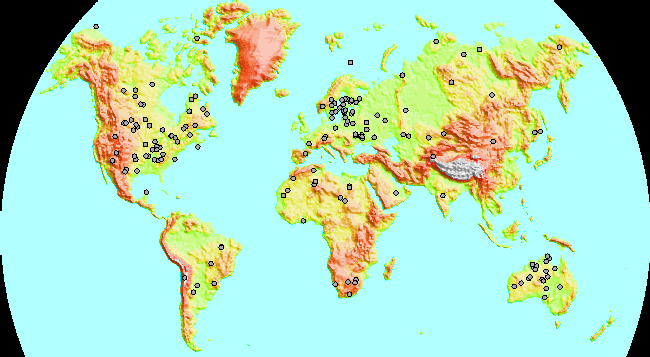
Impact Crater Sites around the World
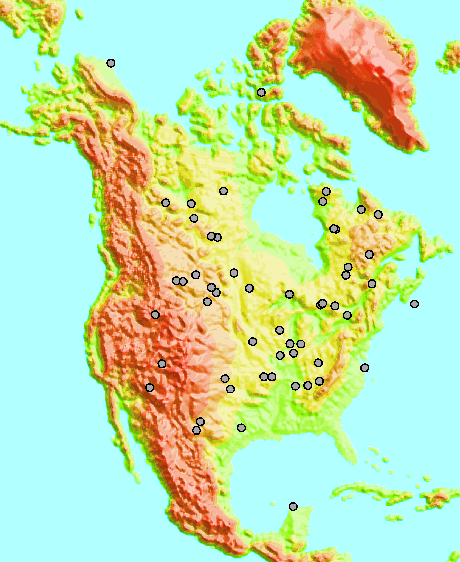
And in North America
IMPACTS AS A HAZARD
The tendency to discount impact processes as a factor in the Earth's more recent geologic history was severely challenged by the interpretation in 1980 that Cretaceous-Tertiary (K-T) boundary sediments world-wide were due to a major impact event and that impact was the causal agent for a mass extinction event. The acceptance of the K-T impact hypothesis by the more general terrestrial geoscience community was not instantaneous and considerable controversy and debate was generated. Today, there are few workers who would deny that there is abundant diagnostic evidence that a major impact event occurred at the K-T boundary. It is fair to say, however, there is less consensus on the role of impact in the associated mass extinction event, with some workers still having difficulty in accepting impact-related processes as the cause.
The impact signal of the K-T event is recognizable globally, because large impact events have the capacity to blow out a hole in the atmosphere above the impact site, permitting some impact materials to be dispersed globally by the impact fireball, which rises above the atmosphere. These materials do not require atmospheric winds for dispersal and have the capacity to encircle the globe in relatively short-time periods, before eventually returning to the surface. Model calculations indicate that it does not require a K-T-sized event, which produced the buried 180 km diameter Chicxulub impact structure in the Yucatan, Mexico, to result in atmospheric blow-out. Relatively small impact events, resulting in impact structures in the 20 km size-range can produce atmospheric blow-out. At present, however, the K-T is the only biostratigraphic boundary with a clear signal of the involvement of a large-scale impact event. The involvement of impact in other boundary events in the terrestrial stratigraphic record has been suggested but little evidence has been offered.
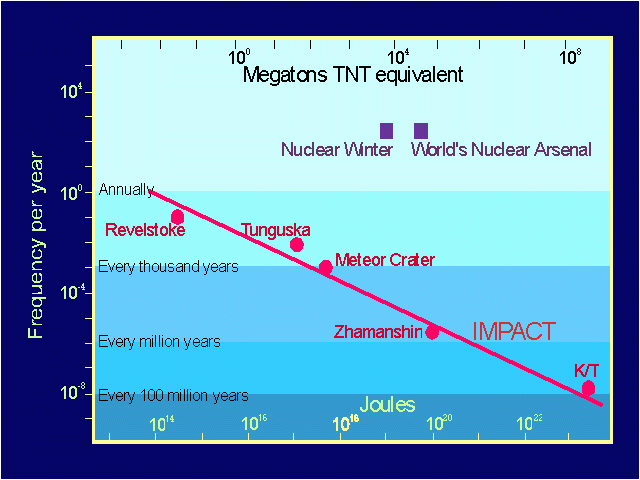
From estimates of the terrestrial cratering rate, the frequency of K-T-sized events on Earth is of the order of one every 50-100 million years. Smaller, but still significant impact events, occur on shorter time scales and will affect the terrestrial climate and biosphere to varying degrees. The formation of impact craters as small as 20 km could produce light reductions and temperature disruptions similar to a nuclear winter. Such impacts occur on Earth with a frequency of two or three every million years. The most recent known structure in this size range is Zhamanshin in Kazaksthan, with a diameter of 15 km and an age of 1 million years. Impacts of this scale are not likely to have a serious affect upon the biosphere and cause mass extinctions. The most fragile component of the present environment, however, is modern human civilization, which is highly dependent on an organized and technologically complex infrastructure for its survival. While we seldom think of civilization in terms of million of years, there is little doubt that if civilization lasts long enough, it will suffer severely or may even be destroyed by an impact event.
Impacts may also induce chemical changes in the atmosphere. These are related to the vaporization of the impacting body and a portion of the target. Considering only the contribution from the impacting body, recent calculations indicate that even relatively small impacting bodies, < 0.5 km in diameter that produce impact craters on the scale of 10 km in diameter, would inject 5 times more sulphur into the stratosphere than its present content. Larger impact events occurring on the time-scale of a million years will inject enough sulphur to produce a drop in temperature of several degrees and a major climatic shift. There are additional effects on atmospheric chemistry, including the potential for the destruction of the ozone layer from shock heating atmospheric nitrogen and the injection of fluorides from the vaporized impacting body. The threshold for these effects appears to be on the time scale of 100,000's of years.
In marine impacts there is also another consideration; namely, the generation of a tsunami. For example, an impact anywhere in the Atlantic Ocean by a body 400 m in diameter would devastate the coasts on both sides of the ocean with wave runups of over 60 m. The 1960 tsunami, generated by a magnitude 8.6 Chilean earthquake, is thought to have been the largest this century. An impact-generated tsunami 10 times more powerful will occur with a typical recurrence time of a few 1000 years. Small impacting bodies release their energy in the atmosphere, as an air burst. The threshold size at which this is exceeded depends on the strength of the impacting body. For example, iron impacting bodies up to 20 m will deposit their energy in the atmosphere and not reach the surface; whereas, comets as large as 200 m will deposit their energy in the atmosphere. Such air burst explosions, fortunately, are not efficient at delivering their energy to the ground, because some of initial energy is blown into space. The Tunguska event in 1908 was due to the atmospheric explosion of a relatively small, approximately few tens of metres, body at an altitude of 10 km. The energy released, has been estimated to be 10-100 megatons TNT equivalent. Although the air blast resulted in the devastation of 2000 sq. km of Siberian forest there was no loss of human life due to the very sparse population. Events such as Tunguska occur on a time-scale of 100's of years.
 Famous 1928 picture of 1908 Tunguska event.
Famous 1928 picture of 1908 Tunguska event.
It must be remembered that impact is a random process not only in space but also in time. The next large impact with the Earth could be an "impact-winter"-producing event or even a K-T-sized event. To emphasize this point, in March 1989 an asteroidal body named 1989 FC passed within 700,000 km of the Earth. This Earth-crossing body was not discovered until it had passed the Earth. It is estimated to be in the 0.5 km size-range, capable of producing a Zhamanshin-sized crater or a devastating tsunami.
Although 700,000 km is a considerable distance, it translates to a miss of the Earth by only a few hours, when orbital velocities are considered. At present, no systems or procedures are in place, specifically for mitigating the effects of an impact.
Information Source: Canadian Regional Geophysics Section on Terrestrial Impact Structures
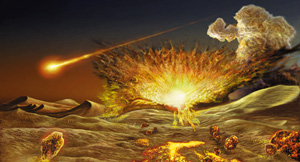
A desert impact site demonstrates the wrath of rocks from space
by Jeffrey C. Wynn and Eugene M. Shoemaker
Imagine, for a moment, that you are standing in the deep desert, looking northwest in the evening twilight. The landscape is absolutely desolate: vast, shifting dunes of grayish sand stretch uninterrupted in all directions. Not a rock is to be seen, and the nearest other human being is 250 kilometers away. Although the sun has set, the air is still rather warm-50 degrees Celsius-and the remnant of the afternoon sandstorm is still stinging your back. The prevailing wind is blowing from the south, as it always does in the early spring.
Suddenly, your attention is caught by a bright light above the darkening horizon. First a spark, it quickly brightens and splits into at least four individual streaks. Within a few seconds it has become a searing flash. Your clothes burst into flames. The bright objects flit silently over your head, followed a moment later by a deafening crack. The ground heaves, and a blast wave flings you forward half the length of a football field. Behind you, sheets of incandescent fire erupt into the evening sky and white boulders come flying through the air. Some crash into the surrounding sand; others are engulfed by fire.
Glowing fluid has coated the white boulders with a splatter that first looks like white paint but then turns progressively yellow, orange, red and finally black as it solidifies-all within the few seconds it takes the rocks to hit the ground. Some pieces of the white rock are fully coated by this black stuff; they metamorphose into a frothy, glassy material so light that it could float on water, if there were any water around. A fiery mushroom cloud drifts over you now, carried by the southerly breeze, blazing rainbow colors magnificently. As solid rocks become froth and reddish-black molten glass rains down, you too become part of the spectacle-and not in a happy way.
Deep in the legendary Empty Quarter of Saudi Arabia-the Rub' al-Khali-lies a strange area, half a square kilometer (over 100 acres) in size, covered with black glass, white rock and iron shards. It was first described to the world in 1932 by Harry St. John "Abdullah" Philby, a British explorer perhaps better known as the father of the infamous Soviet double-agent Kim Philby. The site he depicted had been known to several generations of roving al-Murra Bedouin as al-Hadida, "the iron things."
There is a story in the Qur'an, the holy book of Islam, and in classical Arabic writings about an idolatrous king named Aad who scoffed at a prophet of God. For his impiety, the city of Ubar and all its inhabitants were destroyed by a dark cloud brought on the wings of a great wind. When Philby's travels took him to the forbidding Empty Quarter, his guides told him that they had actually seen the destroyed city and offered to take him there. Philby gladly accepted the offer to visit what he transliterated in his reports as "Wabar," the name that has stuck ever since.
What he found was neither the lost city of Ubar nor the basis for the Qur'anic story. But it was certainly the setting of a cataclysm that came out of the skies: the arrival of a meteorite. Judging from the traces left behind, the crash would have been indistinguishable from a nuclear blast of about 12 kilotons, comparable to the Hiroshima bomb. It was not the worst impact to have scarred our planet over the ages. Yet Wabar holds a special place in meteor research. Nearly all known hits on the earth have taken place on solid rock or on rock covered by a thin veneer of soil or water. The Wabar impactor, in contrast, fell in the middle of the largest contiguous sand sea in the world. A dry, isolated place, it is perhaps the best-preserved and geologically simplest meteorite site in the world. Moreover, it is one of only 17 locations-out of a total of nearly 160 known impact structures that still contain remains of the incoming body.
Krakatau erupted in 1883, in one of the largest eruptions in recent time. Krakatau is an island volcano along the Indonesian arc, between the much larger islands of Sumatra and Java (each of which has many volcanoes also along the arc). In May, 1883, a series of eruptions commenced which continued until August 27, 1883, when a cataclismic explosion blew the island apart.
The large explosion was due to super-hot steam, created when the walls of the volcano ruptered and let ocean water into the magma chamber. The island exploded with the force of 100 megatons (the Hiroshima bomb was about 20 kilotons).
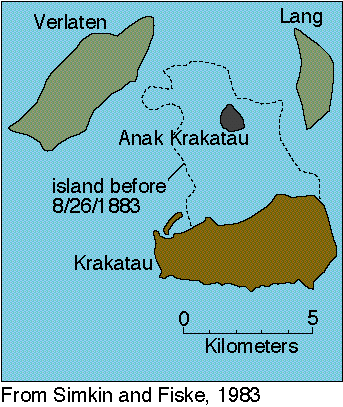
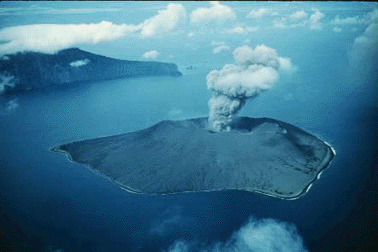
The remains of Krakatau
Summary of Impacts
1. The explosions were heard on Rodriguez Island, 4653 km distant across the Indian Ocean, and over 1/13th of the earth's surface.
2. Ash fell on Singapore 840 km to the N, Cocos (Keeling) Island 1155 km to the SW, and ships as far as 6076 km WNW. Darkness covered the Sunda Straits from 11 a.m. onthe 27th until dawn the next day.
3. Giant waves reached heights of 40 m above sea level, devastating everything in their path and hurling ashore coral blocks weighing as much as 600 tons.
4. At least 36,417 people were killed, most by the giant sea waves, and 165 coastal villages were destroyed.
5. When the eruption ended only 1/3 of Krakatau, formerly 5x9 km, remained above sea level, and new islands of steaming pumice and ash lay to the north where the sea had been 36 m deep.
6. Every recording barograph in the world ducumented the passage of the airwave, some as many as 7 times as the wave bounced back and forth between the eruption site and its antipodes for 5 days after the explosion.
7. Tide gauges also recorded the sea wave's passage far from Krakatau. The wave "reached Aden in 12 hours, a distance of 3800 nautical miles, usually traversed by a good steamer in 12 days".
8. Blue and green suns were observed as fine ash and aerosol, erupted perhaps 50 km into the stratosphere, circled the equator in 13 days.
9. Theree months after the eruption these products had spread to higher latitudes causing such vivid red sunset afterglows that fire engines were called out in New York, Poughkeepsie, and New Haven to quench the apparent conflagration. Unusual sunsets continued for 3 years.
10. Rafts of floating pumice-locally thick enouth to support men, trees, and no doubt other biological passengers-crossed the indian Ocean in 10 months. Others reached Melanesia, and were still afloat two years after the eruption.
11. The volcanic dust veil that created such spectacular atmospheric effects also acted as a solar radiation filter. Incoming solar radiation decreased 25 percent and remained 10 percent below normal for about three years. Global temperatures as much as 1.2 degree C in the year after the eruption. Temperatures did not return to normal until 1888.
12. Dr. Gerald G. Kuhn from the Scripps Institution of Oceanography is a leading scientist in this field. His research has shown that even here in southern California we can feel the effects of volcanic eruptions from half way around the world. This was the case after the eruption of Krakatoa in Indonesia. Tropical storms in the eastern Pacific that originate off the western coastline of Mexico normally travel west or northwest harmlessly out to sea. But approximately a year after the eruption of Krakatoa the storm track changed to the north, towards San Diego. Consequently a hurricane turned tropical storm slamed into north San Diego County causeint considerable damage in the area. This unusual event was reported in the local newspaper at the time and later coralated to the Krakatoa event by Dr. Gerald G. Kuhn
PBS Catastrophe! - Part I [Read the
Transcripts of this PBS televison special - Part I] [ Part II ]
1500 years ago something extreme happened to the world's climate-something that must have
terrified those who witnessed it. The sun began to go dark, the skies are turbulent.
Clouds of dust enveloped the earth.
Now comes bizarre weather. Rain poured red, as if tinted by blood. Snow falls
yellow. Cold gripped the land for two years. Seasons are blurred, There is frost and
drought. Then came Famine, Plague and Death. Whole cities were wiped out -
civilizations crumbled. The world will never be the same. There is evidence of
a catastrophe -- a catastrophe whose consequences affected the entire world-and may have
changed the course of human history.
"The mid 6th century catastrophe was the most important date in the history of
the past two thousand years. It really did lay the foundations of the world we live in
today."
The theory belongs to David Keys. With dogged detective work he has pieced together the
story of an ancient catastrophe.
By bringing together evidence from contemporary eye witness accounts and tree rings- he
has developed a picture of a lethal climate change that began in the year 535AD and
affected most of the world for the next ten to twenty years.
He found three possible causes for the huge amounts of dust, ash and water vapour that
must have been hurled into the atmosphere to block out the sun-a comet, an asteroid or a
volcano. The presence of sulphuric acid in arctic and Antarctic ice cores from that period
has pointed the finger at a massive volcanic eruption. But where did it occur? From
Chinese and Japanese records, Keys has deduced that the culprit could have been the
world's most notorious volcano - Krakatoa.
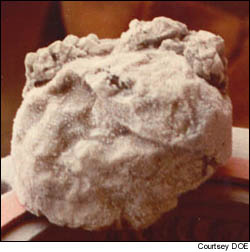
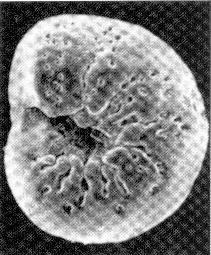
1) Vast quantities of methane were stored as frozen gas hydrate in the upper 1,500 feet of continental slope sediments.
2) MICROSCOPIC CREATURES, including this foraminifer called Stensioina beccariiforrnis, died in droves when their ocean-bottom homes heated up during a worldwide climate fever about 55 million years ago.
Historic global warming
linked to methane release
By John Roach
An intense period of global warming about 55.5 million years ago has been linked to a massive release of methane, an event that killed many deep-sea species and enabled terrestrial animals to flourish, according to an article in today's issue of the journal Science.
The warming, known as the "latest Paleocene thermal maximum," occurred over a 10,000 to 20,000-year interval and corresponds to the appearance of numerous mammals (including primates) and the extinction or temporary disappearance of many deep-sea species.
The link between this warming period and the methane release is based on analysis of a sediment core taken from the ocean floor and is the first tangible evidence of a long held hypothesis, said Dorothy Pak, a researcher at the University of California, Santa Barbara, and co-author of the study.
According to the hypothesis, vast quantities of methane were stored as frozen gas hydrate in the upper 1,500 feet of continental slope sediments before the latest Paleocene thermal maximum, during which ocean waters warmed by 7 to 14 degrees.
Oxford scientists studied fossil wood deposits and identified a signal that they say indicates an unusual level of light carbon in the Earth's atmosphere.
"It's a question of trying to identify what the source of the light carbon would be," Hesselbo said. "The best explanation in this case is that it comes from methane -- methane hydrate from ocean margin sediment."
The researchers believe massive volcanic eruptions during the Jurassic period initiated global warming by spewing carbon dioxide and other greenhouse gases into the atmosphere. Deep-sea currents also were affected.
Methane, freed from its suboceanic cage by warmer water, then used the oxygen in the water or atmosphere to form carbon dioxide. In either case, it would have accelerated global warming.
"A number of important fossil groups disappeared at exactly that time," Hesselbo said. "The extinction and the association with the lack of oxygen has been fairly well established, but the association with methane release is something that hasn't been realized before."
Hardest hit were bottom-feeding clam-like organisms known as bivalves: An estimated 80 percent of the species disappeared. Others affected included ostacods, belemnites and some marine plants.
The researchers believe the event took place over a period of 5,000 years -- a blink in geologic time. The release was estimated to be 20 percent of the present-day 14,000 billion tons of gas hydrate on the sea floor.